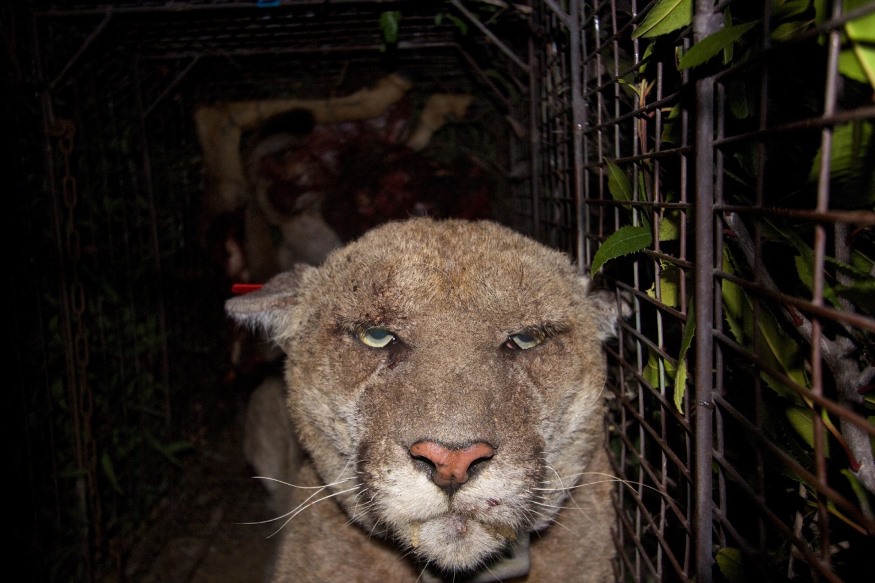|
You are viewing ARCHIVED content published online before January 20, 2025.
Please note that this content is NOT UPDATED, and links may not work. For current information,
visit https://www.nps.gov/aboutus/news/index.htm.

National Park Service
Contact: Kate Kuykendall, 805-370-2343 THOUSAND OAKS, Calif. – Test results received last week confirm the Griffith Park mountain lion known as P-22 has been exposed to anti-coagulant rodenticide, commonly known as rat poison, and is suffering from mange. The National Park Service (NPS) study has previously documented two mountain lion deaths as a result of rodenticide poisoning."Anti-coagulant rodenticides are designed to kill rodents by thinning the blood and preventing clotting," said Dr. Seth Riley, an urban wildlife expert at Santa Monica Mountains National Recreation Area. "When people put these bait traps outside their homes or businesses, they may not realize that the poison works its way up the food chain, becoming more lethal as the dose accumulates in larger animals."
Tests conducted by the California Animal Health and Food Safety Lab at UC Davis showed diphacinone and chlorophacinone in P-22's blood, two first-generation anti-coagulant compounds. Recent legislation banned the retail sale of second-generation anti-coagulant rodenticides as of July 1, but does not impact the sale of diphacinone or chlorophacinone.
During nearly two decades of research in and around the Santa Monica Mountains, NPS scientists, working with UCLA graduate student Laurel Serieys, have documented widespread exposure to common household poisons in carnivores, sometimes leading to death. Of 140 bobcats, coyotes and mountain lions evaluated, 88% tested positive for one or more anti-coagulant compounds.
The connection between exposure to anti-coagulant rodenticide and mange, a parasitic disease of the hair and skin, is still not fully understood. Mange in wild cats is rare and only two other mountain lions in the 12-year study have developed mange, with both ultimately dying of rodenticide poisoning. More is known about mange in bobcats, with previous NPS research finding that bobcats that have ingested rodenticide are much more likely to suffer from severe mange.
P-22 was captured in late March in order to replace the battery in his GPS collar. Noting his mangy appearance, biologists treated him with selamectin, a topical treatment for ectoparasitic diseases such as mange, fleas and ticks. Biologists hope the treatment is successful, but it remains unclear whether P-22 will fully recover.
There is no indication that P-22 poses a safety threat. Despite the mange, he continues to spend the majority of his time in the most natural areas ofGriffith Park, occasionally testing his boundaries and exploring more urban locations. He continues to successfully hunt his natural prey, which is mule deer. For more information on living in mountain lion country, click here.
After being detected by biologists with the Griffith Park Wildlife Connectivity Study, P-22 was captured by NPS biologists and outfitted with a GPS collar in March of 2012. Genetic testing from UCLA and UC Davis revealed that he was likely born in the Santa Monica Mountains and therefore would have had to cross both the 405 and 101 Freeways to make it to Griffith Park.
His image famously appeared in the December 2013 issue of National Geographic Magazine, with the Hollywood sign as the backdrop.
Since 2002, the National Park Service has been studying mountains lions in and around the Santa Monica Mountains to determine how they survive in an increasingly fragmented and urbanized environment. Funding for mountain lion research in the Santa Monica Mountains is provided in part through private donations to the Santa Monica Mountains Fund.
Santa Monica Mountains National Recreation Area (SMMNRA) is the largest urban national park in the country, encompassing more than 150,000 acres of mountains and coastline in Ventura and Los Angeles counties. It comprises a seamless network of local, state and federal parks interwoven with private lands and communities. As one of only five Mediterranean ecosystems in the world, SMMNRA preserves the rich biological diversity of more than 450 animal species and 26 distinct plant communities. Visit www.nps.gov/samo.
###
|
Last updated: May 11, 2022
